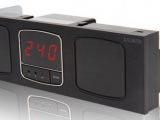Most end-users are satisfied with reading how much power their components use off the specification sheets, but there are those that want to be informed at all times, especially during overclocking and such, so Zalman figured it would do something about it.
It would appear that enthusiasts now have an easy way of keeping track of how much energy their most power-hungry PC components consume.
For those that may not know, the two most energy-draining components of a computer are usually the central processing unit and the graphics card.
Verily, the graphics card alone can sometimes be seen as the main factor one has to consider when buying the power supply unit (PSU).
In fact, the power draw of the VGA card becomes an even more important element if one were to use more than one at a time, in multi-GPU setups.
This issue became particularly prominent when the NVIDIA GeForce GTX 480 came out, which was especially merciless in its treatment of PSUs (though it has since been replaced by the more tempered yet stronger GTX 580).
Since enthusiasts often find the need to know the exact electricity usage of their hardware, Zalman created the ZM-VPM1 amd ZM-PCM1.
The ZM-VPM1 is meant to monitor VGA cards and can cope with one or two boards (equipped with 8-pin or 6-pin PCIe power plugs) at the same time.
The product can return VGA voltage and current, in addition to the actual consumption, and all information is delivered in real-time.
For the CPU, the company created the aforementioned ZM-PCM1, which is meant to be placed inside a 5.25-inch drive bay.
It is compatible with ATX12V 4-pin or EPS12V 8-pin setups and, like its VGA counterpart, can show power draw in real-time.
They should already be found on sale online, priced at £24.99 (ZM-VPM1) and £34.99 (ZM-PCM1).

 14 DAY TRIAL //
14 DAY TRIAL // 
